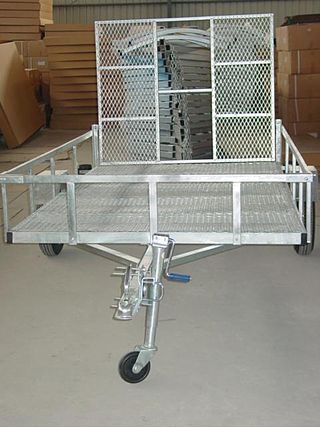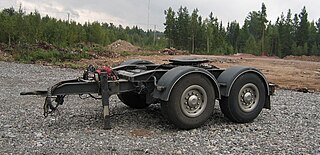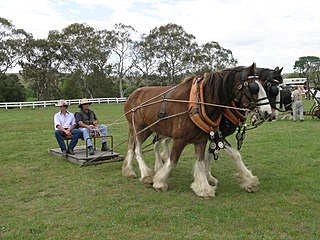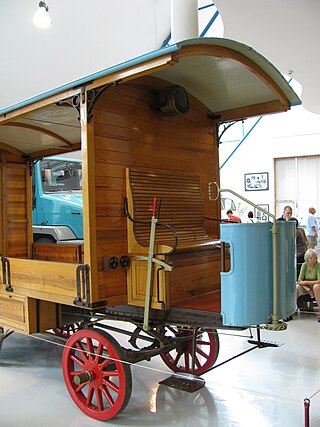
A bogie is a chassis or framework that carries a wheelset, attached to a vehicle—a modular subassembly of wheels and axles. Bogies take various forms in various modes of transport. A bogie may remain normally attached or be quickly detachable. It may include a suspension component within it, or be solid and in turn be suspended ; it may be mounted on a swivel, as traditionally on a railway carriage or locomotive, additionally jointed and sprung, or held in place by other means.

A cart or dray is a vehicle designed for transport, using two wheels and normally pulled by draught animals such as horses, donkeys, mules and oxen, or even smaller animals such as goats or large dogs.

A caster is an undriven wheel that is designed to be attached to the bottom of a larger object to enable that object to be moved.

A trailer is an unpowered vehicle towed by a powered vehicle. It is commonly used for the transport of goods and materials.

A flatcar (US) is a piece of rolling stock that consists of an open, flat deck mounted on a pair of trucks (US) or bogies (UK), one at each end containing four or six wheels. Occasionally, flat cars designed to carry extra heavy or extra large loads are mounted on a pair of bogies under each end. The deck of the car can be wood or steel, and the sides of the deck can include pockets for stakes or tie-down points to secure loads. Flatcars designed for carrying machinery have sliding chain assemblies recessed in the deck.

A toy wagon has the same structure as the traditional, larger wagon, but is much smaller and has an open top. An average wagon is able to seat one child, and is generally propelled by human power through a handle at the front. Some famous brands are Radio Flyer, Little Tikes, Red Rider, Northern Tool and Equipment, Lowe's, Cardinal, and Speedway Express.

A hand truck, also known as a hand trolley, dolly, stack truck, trundler, box cart, sack barrow, cart, sack truck, two wheeler, or bag barrow, is an L-shaped box-moving handcart with handles at one end, wheels at the base, with a small ledge to set objects on, flat against the floor when the hand-truck is upright. The objects to be moved are tilted forward, the ledge is inserted underneath them, and the objects allowed to tilt back and rest on the ledge. The truck and objects are then tilted backward until the weight is balanced over the wheels, making otherwise bulky and heavy objects easier to move. It is a first-class lever.

A horse-drawn vehicle is a piece of equipment pulled by one or more horses. These vehicles typically have two or four wheels and were used to carry passengers or a load. They were once common worldwide, but they have mostly been replaced by automobiles and other forms of self-propelled transport but are still in use today.

Among horse-drawn vehicles, a trolley was a goods vehicle with a platform body with four small wheels of equal size, mounted underneath it, the front two on a turntable undercarriage. The wheels were rather larger and the deck proportionately higher than those of a lorry. A large trolley is likely to have had a headboard with the driver's seat on it, as on a lorry but a smaller trolley may have had a box at the front of the deck or the driver seated on a corner of the deck and his feet on a shaft. With a very small trolley, the 'driver' may even have led the horse as a pedestrian. They were normally drawn by a single pony or horse but a large trolley would have a pair.

A lorry or lorrie was a low flat horse-drawn vehicle with no sides, related to the trolley and dray.

A dolly is an unpowered vehicle designed for connection to a tractor unit, truck or prime mover vehicle with strong traction power.

A semi-trailer is a trailer without a front axle. The combination of a semi-trailer and a tractor truck is called a semi-trailer truck.

A flatbed truck is a type of truck the bodywork of which is just an entirely flat, level 'bed' with no sides or roof. This allows for quick and easy loading of goods, and consequently they are used to transport heavy loads that are not delicate or vulnerable to rain, and also for abnormal loads that require more space than is available on a closed body. Flatbed trucks can be either articulated or rigid.

A lowboy is a semi-trailer with two drops in deck height: one right after the gooseneck and one right before the wheels. This allows the deck to be extremely low compared with other trailers. It offers the ability to carry legal loads up to 12 ft (3.66 m) tall, which other trailers cannot. Lowboys are used to haul heavy equipment such as bulldozers and large industrial equipment.

A stone-boat is a type of sled (sledge) for moving heavy objects such as stones or hay bales. Originally they were for animal-powered transport used with horses or oxen to clear fields of stones and other uses and may still be used with animals or tractors today.

Nesselsdorfer Wagenbau-Fabriks-Gesellschaft (NW) First Truck is an antique truck manufactured by Nesselsdorfer Wagenbau-Fabriks-Gesellschaft A.G. in 1899. A unique feature of the engine setup was that the two engines could be operated sequentially depending on the load requirements. After the company finished its first passenger car, named the Präsident, it focused on manufacturing a truck. The First Truck represents the beginning of the long tradition of Tatra commercial vehicles.

The Canon de 19 C modèle 1875 was a coastal defense gun designed and built in the 1870s. A number of guns were also converted to railway guns during World War I in order to meet a need for heavy artillery.
Airport dollies for unit load device (ULD) and cargo pallets are standard sized flatbed trolley or platform, with many wheels, roller bars or ball bearings protruding above the top surface for easy loading and unloading of ULD and cargo pallets respectively. Since ULD/pallet rest on ball bearings, these dollies are equipped with hinge/locks to secure the position of the ULD/pallet on them during tugging transportation. The aviation industry adopted ULD/pallets to be lightweight containers and supporting platforms respectively, intended to be loaded into aircraft and fly along with their loads, they need to be minimum in weight and thus do not have wheels or strong base structure. Also, the ULD/pallets have stringent dimensional standard following the aircraft cargo bay dimension. Therefore, these dollies are custom designed to complement the ULD/pallet's dimension, hinge/fixture position, weak overall physical strength and transportation need. Advanced dollies for ULD and pallets, such as those used on an airport apron, may have the following specialized facilities:




















